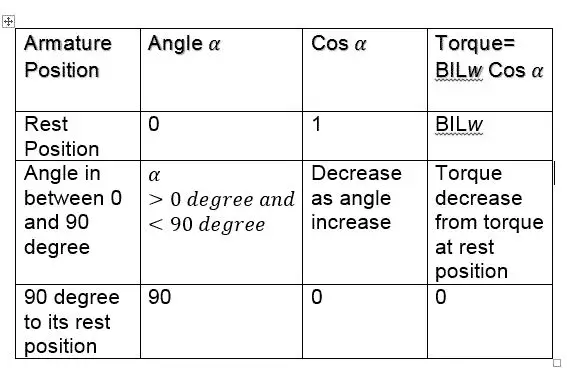The DC motor converts electrical energy into mechanical energy. The input power to the DC motor is DC power. The DC motor works on the principle of Lorenz law which states that when the current carrying conductor is placed in a magnetic field, it experiences a force. The force is called the Lorenz force, and its direction can be found by Fleming’s left-hand rule.
Working Principle of DC Motor
The DC motor has armature and field winding. The armature is connected to the DC supply source through a commutator segment and carbon brushes. The armature is placed under the magnetic field. The magnetic field is produced in the DC motor when its field winding is energized with a DC supply.
The single-loop construction of the DC motor is given below.
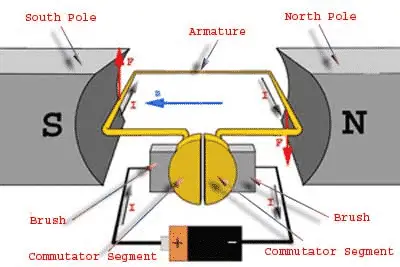
The DC motor has armature and field winding. The armature is connected to the DC supply source through a commutator segment and carbon brushes. The armature is placed under the magnetic field. The magnetic field is produced in the DC motor when its field winding is energized with a DC supply.
When the current-carrying armature conductor is placed under the magnetic field, the conductor experiences a force. The direction of the force experienced by the conductor can be determined by Fleming’s left-hand rule.
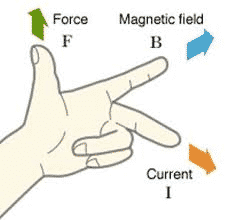
According to Fleming’s left-hand rule, if we extend the index finger, middle finger, and thumb of our left hand in such a way that the middle finger is in the direction of current in the conductor, and the index finger is along the direction of magnetic field, i.e., north to south pole, then thumb indicates the direction of the created mechanical force.
Magnitude of Force
When infinitely small charge dq is made to flow at a velocity of v under the electric field E and magnetic field B, then the Lorenz force experienced by charge dq is given by;
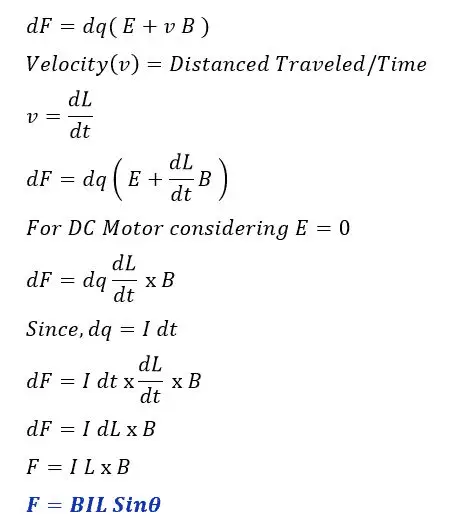
In a DC motor, the direction of current through the armature conductor at all instants is perpendicular to the field. The current on the left-hand side of the coil is I, and the current on the side of the coil is -I.
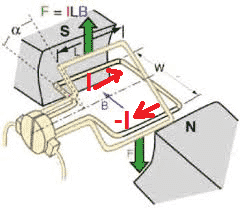
The force acting on the left-hand side coil is;
F = BIL Sinθ
θ = 90∘
F = BIL Sin90 [ Sin 90∘ = 1 ]
F= BIL
The force acting on the right-hand side coil is;
Fr = BIL Sinθ
θ = 90∘
Fr = B(-I )L Sin90 [ Sin 90∘ = 1 ]
Fr = – BIL
Thus the equal magnitude of the force is developed at the two sides of the coil.However, the direction of both the forces is opposite to each other. The opposite force acting on the two sides of a coil, which are distance apart by ‘w’, causes rotation of the coil, and the coil starts rotating. In this way, rotational torque is produced in DC motor.
Magnitude of Torque
The torque of the DC motor
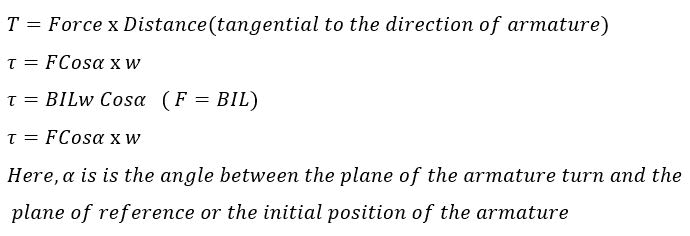
The torque produced by a DC motor depends on the angle between the plane of the armature turn and the plane of reference. When the armature is at rest, it produces maximum torque, and the torque reduces with an increase in angle.
